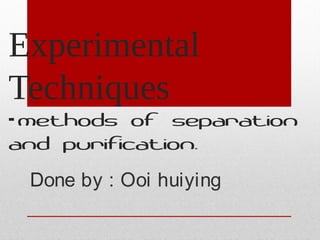
Science chemistry @ Separation and purifying methods.ppt
- 1. Experimental Techniques - methods of separation and purification. Done by : Ooi huiying
- 2. Solid-solid Filt r at ion Cr yst allisat ion & Evapor at ion t o dr yness Simple dist illat ion Solid-liquid Sublimat ion Dissolving & f ilt r at ion Liquid-liquid Separ at ing f unnel Fr act ional dist illat ion Types of mixtures
- 4. a) Filtration : separating an insoluble solid from liquid This method is used to separate an insoluble solid from a liquid in a liquid- solid mixture. The filter paper has tiny pores that allow the liquid component to pass through it. The insoluble solid particles that are too large to pass through the filter paper are left behind in the filter funnel. The insoluble solid is called the residue and the liquid that passes through is called the filtrate. Separating a solid from solid- liquid mixture ( Filtration)
- 5. b) Crystallisation and evaporation to dryness During crystallisation, the concentrated sugar mixture is heated until saturated, that is, at crystallisation point. The solution is left to cool so that the excess sugar in the mixture will precipitate out as crystals. Some salts such as copper sulfate, are also separated out from their solutions by crystallisation. Crystallisation is a separation method used to obtain pure sugar crystals from a mixture. This method is suitable for salts that decompose if evaporated to dryness on heating. Evaporation to dryness is used to separate a dissolved solid from a liquid. The dissolved solid must be heat-stable. In this method, the mixture is heated. When the mixture has completely evaporated, no water is left behind. The solid salt left behind as the residue. Separating a solid from solid- liquid mixture (crystallisation & evaporation to dryness)
- 6. • c)Simple distillation : Separating a liquid from a solution Distillation is used to separate a pure liquid from solid-liquid or liquid- liquid mixture. The two main processes involved in distillation are boiling and condensation. The pure liquid collected from distillation is called the distillate. The solid that remains in the distillation flask is called the residue. Uses: -To make perfumes -Desalination plants Separating a solid from solid- liquid mixture ( simple Distillation)
- 7. 1) Sublimation: Separating a solid that sublimes on heating Sublimation is the process whereby the substances changes from the solid state to gaseous state directly. Sublimation is used to separate a solid that sublimes upon heating from another substance with a high melting point. The mixture is placed in an evaporating dish. An inverted funnel is placed over the mixture. On gentle heating, the salt sublimes and is deposited on cold filter funnel. This method has limited uses because very few solids will sublime on heating. Among those that will sublime are ammonium salts, iodine, dry ice ( CO2). Separating a solid from a solid-solid mixture (Sublimation)
- 8. 2) Dissolving and filtration: When only one solid is soluble A mixture of two solids can be separated by carefully choosing a solvent in which only one of the solids is soluble. The mixture of two solid can be used to mix with liquid. The soluble solid can be used to dissolve in liquid, and a mixture is formed. Then filtration can occur. The filter paper has tiny pores that allow the liquid component to pass through it. The insoluble solid particles that are too large to pass through the filter paper are left behind in the filter funnel. The insoluble solid is called the residue and the liquid that passes through is called the filtrate. E.g. : To separate Copper (11) sulfate from a mixture of copper (11) oxide and copper (11) suifate. Separating a solid from a solid- solid mixture (Dissolving and filtration)
- 9. • 1) Separating funnel : Separating immiscible liquid Liquids that do not dissolve in each other are described as immiscible. Oil and water are immiscible in each other. Pour the mixture of oil and water into the separating funnel. Wait until two layers are formed. Water is denser than oil. It will form the bottom layer. Open the tap. Allow water (the bottom layer) to run into a beaker. Close the tap, before the top layer runs out. Place another beaker below the funnel. Open the tap to allow the oil to run out. Separating liquid-liquid mixture ( Separating Funnel )
- 10. • b) Fractional distillation : Separating miscible liquids Miscible liquids are liquids that dissolve in each other completely to form a solution. Fractional distillation can be used to separate a liquid-liquid mixture which is miscible and can only be used if liquids have different boiling points. A tall fractionating column is used. It allows the separation of different liquids more efficiently. It contains many glass beads which provides a large surface area for the vapour to condense on. The substance with a lower boiling point is distilled first. Uses : Separation of liquid air Separation of crude oil ( or petroleum) Separation of ethanol from glucose solution Separating liquid-liquid mixture (Fractional distillation)
- 11. It is used to separate a mixture which is based on the extent of solubility in a given solvent. The result of the separated components on the chromatography paper is called the chromatogram. The more soluble the component in the solvent, the further distance it travels on the chromatography paper. Advantage: Gives quick & accurate analysis of sample, Requires only a small amount of sample, Able to separate complex mixtures such as food dyes or flavouring or the dyes in inks. Rf=distance travelled by the substance distance travelled by the solvent Paper chromatography
- 12. The End
